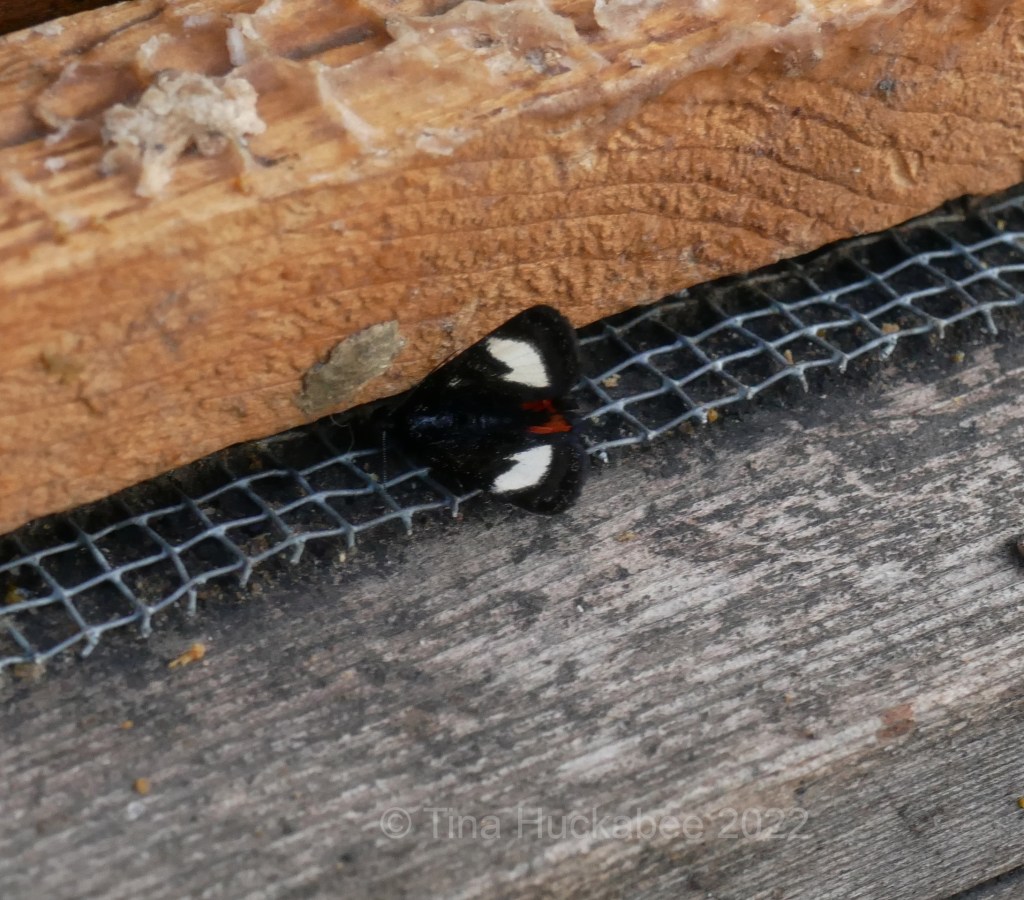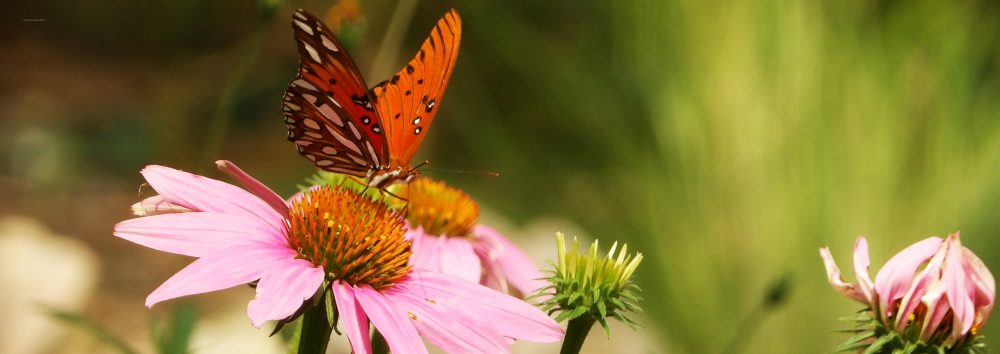Last week a cold front barreled into Austin, dropping temperatures 56 degrees, from 88F to 32F within a 24 hour span. As the wind picked up in late afternoon and I was covering a few of my container plants, I ambled to our lone beehive, Bo-Peep, noticing that the ladies were heading inside, having finished foraging on that warm day, soon to be cold night. I don’t know if they knew that it would be freezing for the next few days, but it would make some sense that they were snuggling in for the duration of the chill.
On the entry board of the hive, this stunning moth was also ambling about; the bees ignored the moth, the moth ignored the bees.

I’ve seen this species of moth before, mostly in flight, but it was always too quick for me to identify. A Grapevine Epimenis, Psychomorpha epimenis, this moth species uses grape plants as its host plant, meaning that it lays eggs on the plants, the larvae eat the plant as they mature to adulthood. In one local source that I found, the author mentions that the adults typically fly in February, laying their eggs on the still dormant vine. My Mustang Grape vine, Vitis mustangensis, has grown along a trellis for a number of years and is courtesy of a passing bird, raccoon–or something. I’ve never noticed caterpillars on the vine, but will keep a keen eye out for them in the next couple of months.
This moth sports red spots on its wings, indicating that it’s a male; females’ spots are orange. I was able to catch a glimpse of the underside of the wing, too. I like the mottled grey/black pattern, black dots on charcoal grey background. What a handsome fella!

During my winter pruning frenzy, I recently pulled some of the grape vine, which I’m now regretting. Though there’s still plenty of vine left and probably eggs on the vine, I wish I’d been aware that the vine is a host plant. Next year, I’ll leave the vine alone until later in spring, giving the larvae time to hatch, eat, grow, and become lovely little moths to grace my garden.
As it became colder, I wondered if the moth found refuge inside the hive, or if the bees would have tolerated a cold weather interloper. Maybe they became sisters and brother during inclement weather. Or did the moth fly off, finding warmth and protection under leaf or branch elsewhere in the garden?

Lucky find!
LikeLike
It’s good to be in the right place at the right time!
LikeLike
Pretty little thing, so fuzzy! I, too, am just beginning to learn more about host plants. Live and learn. 🙂
LikeLike
It’s lovely! I’m also learning; I’ve read about my mustang grape before, but the fact that it was a host plant hadn’t registered. I’d also seen this little thing flying around before and didn’t make the connection. Sigh.
LikeLiked by 1 person
Ah, the mysteries of life! Such a beautiful creature. Your weather sounds like ours recently, except we were more like 48F to -10F in 24 hours. Lately, though, we’re settling into warmer weather–still with ups and downs, but the lows aren’t quite so bitter.
LikeLike
Brrrr -10F. I was whining at 28F! 🙂 It’s the time of year that the weather ping-pongs. Today I switched from leggings and a light sweater, to shorts and a a t-shirt, back to leggings. My town isn’t getting bomb, though, so I think it’s all okay.
LikeLike
That’s a beautiful moth. I hope it survived the dramatic drop in temperature and that you will soon see some larvae. I think these massive hot-cold swings we keep having with increasing frequency are stressful for all living systems, man, beast, and plant alike.
LikeLike
It’s a strikingly pretty thing, that black with the rich red! We’ve always ping-ponged with our temperatures, especially in spring, but yes, you’re right that climate change exacerbates the changes and swings of the weather patterns. This temperature change was historic and it seems like we’re now always breaking historic records.
I never answered your question last week on your site about my SIL’s garden–it’s coming along beautifully! She’s added a bunch of nice, large shrubs and things that I’ve given her are doing well. I was hoping that we could take out a little more in the front, but we have a drought now, so she’s going to hold off until fall and reassess new plantings. I think she’s really enjoyed having a garden to tend, but, as you well know, it’s work and a commitment.
LikeLiked by 1 person
Aww, that’s wonderful to hear, and also probably a wise decision – however tempting it is to plant new stuff in spring. All power to her!
LikeLiked by 1 person
That is a colorful moth. I have had butterflies in the garden all winter and I do wonder how they survived the cold nights.
LikeLike
I’ve wondered that too, Judy. Like you, I see the butterflies and moths on warmer days, then it gets cold and they disappear. The next warm day? They’re back in the air!
LikeLiked by 1 person
So sweet! I love discovering moths in my garden. Do you have the recently published guide Native Host Plants for Texas Moths? It’s beautiful!
LikeLike
Oooh, thanks for that information, I’ll check that resource, it’s sound great! I’m usually pretty good about checking the LBJWC site for info about whether something is a host plant, but it’d be nice to have a source dedicated to moths and/or butterflies.
LikeLike
The coloration and pattern on the moth is amazing. Lovely find! I worried about cleaning up the garden beds too early but it’s hard to know exactly what might be hiding within.
LikeLike
I think it’s such a strikingly colored little thing and it is little! I try to be careful when pruning, but I’m sure I’ve missed things at times.
LikeLiked by 1 person
I’ve never seen this beauty, although it’s been oft-reported in our area. I’ll have to start looking around the grape vines; heaven knows we have enough of those! What I have seen is the white-tipped black moth Melanchroia chephise. In fact, I found one of those in January sunning on a marina dock. I suppose it was the warmth that attracted it.
LikeLike
This grapevine epimenis is fairly widespread in the south/southeast. I’d seen a black flitty thing with colored wings a time or two in the past and when I spotted it meandering along the hive, it seemed familiar. I didn’t know it had a host plant in my very own garden, but it’s nice to learn that fact.
I think I’ve seen that moth before! My neighbor grows a Wooly Butterfly Bush (Buddleja marrubiifolia) (https://www.wildflower.org/plants/result.php?id_plant=buma) in her garden, and a few years back, walking by her garden I saw one of those (at least I think it was your moth) on a bloom. Very handsome moth!
LikeLike
The moth is divine with such fabulous colors. I hope she survived that sudden drop in temperature just like all the bees in Bo-Peep. Tina your vine, even if moth larvae come out, I’m sure it will recover. The associations do not put them in most of the books or on the internet, it is the result of experience and of being very aware of what happens in each plant. Tina I’m sure you have a lot of experience in this. I loved your blog. Take good care of both of you. I wish you the best. Very affectionate greetings from Margarita.
LikeLike
Thank you, Margarita. I was thrilled to see it and am glad that it wasn’t flying so I could photograph it. Take care, hope spring is lovely for you in Madrid.
LikeLike
What a beautiful moth that is certain to return!
LikeLike
Have you ever seen any of the very old mustang grape vines that have grown so thick and woody you could almost take them for trees?
LikeLike
I have and they’re impressive. Mine are little wimps!
LikeLike